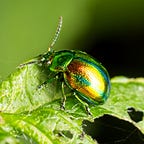Photographing Insects: A New Season
Insects are appearing again, to be photographed in many new ways
It is springtime and insects are appearing again everywhere. My book on insect photography is finally finished and translated into Dutch, so I have plenty of time again to go out and take insect shots. There are many techniques that I want to try this year, that should lead to different kinds of insect shots. Here are some ideas I plan to investigate.
Lenses
Last year I took most of my insect shots with a Canon 100 mm macro lens. Before buying that lens I used an 18–150 mm lens with 31 mm extension tubes, which functioned largely in the same way (but less convenient). Most of my shots were taken at a pretty close range.
This year I also want to experiment with two different lenses. I own a 100–400 mm telelens that still has a decent magnification factor. Using this lens, in particular at the longer end, will have a number of effects:
- I can stay further away from the insects.
- The depth of field is reduced, leading to less sharpness in the complete insect, but a nicer bokeh.
- The images will feel more compressed, showing less of the background.
This can lead to rather different shots, in particular of larger insects.
The other lens is the Canon RF-S 10–18 mm wide-angle lens. Also, this lens has a decent magnification, but you need to get very close to the subjects. This lens has the exact opposite effects:
- I need to get much closer to the subjects.
- The depth of field is increased, leading to completely sharp insects and a more visible background.
- Much more of the background is visible, showing more of the environment the insect is in.
This lens will be particularly nice when the insect sits on the rim of a flower or leaf and there is open space around or behind it.
Experimenting with these two lenses, I hope to be able to extend the range of shots I can create.
Composition
Most of my photos so far were insect portraits, that is, the insect was the main subject and filled a large part of the frame. I want to experiment with different compositions in which the insect is just part of the scene. This will mean taking pictures from a larger distance and being way more aware of the environment the insect is in.
Shooting such wider images will lead to different challenges. Getting the insect sharp will be less of an issue as the magnification will be smaller. However, getting the right environment will be more difficult as you have no control over the location of the insects. I will also have to think a lot more about composition rules, like the rule of thirds and visual balance while taking the shots.
Light
Up to now I almost always took my shots with a flash with a large diffuser. I used exposure settings that removed almost all effects of ambient light. This led to shots in which the insect is shown in all its details and there are no ugly shadows. It made exposure easy and let me concentrate on focus and composition instead.
This year I want to experiment more with other types of light and ways to use light.
- Using ambient light at different times of the day and in different weather conditions.
- Using back-lighting with ambient light or a flash, for example, to show the transparency of insect wings.
- Using flashes from different directions.
- Using deflectors.
- Using continuous lighting.
This should lead to more creative shots, for example, low-key and high-key pictures.
Butterflies and dragonflies
I will continue to shoot all insects I can find, but I will put special focus on photographing butterflies and dragonflies. We formed a small group of photographers in the Netherlands that will spend 2024 learning everything there is to know about photographing these larger insects. They are by far the most popular types of insects for photography. But they can also pose many challenges to creating interesting shots. One particular challenge is to photograph them in flight.
I think 2024 will be an exciting year for my insect photography, and I will share all I learn through posts here. If there is anything particular you would like me to investigate as well, please let me know in the comments.
Mark Overmars is a dedicated insect photographer who loves to share and regularly publishes about his work and about photography in general. You can visit his website at www.insectphotography.org. Download his free insect photography book at www.insectphotography.org/book.
